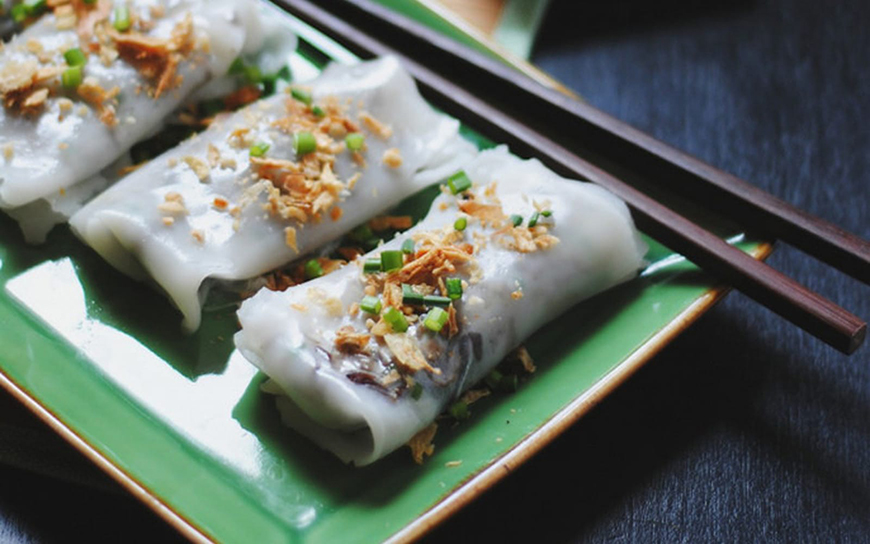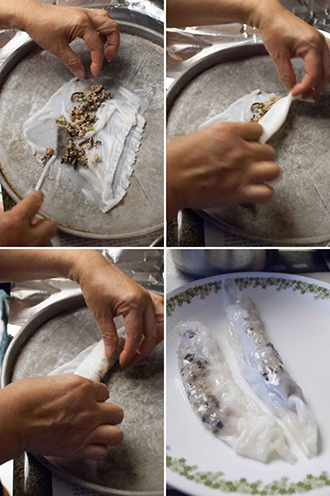Banh Cuon is much more than just a Vietnamese dish. It's a culinary heritage rich in tradition and flavor, a symbol of sharing and conviviality. Its delicacy, lightness and variety make it a dish appreciated by all, and its place in Vietnamese culture is indisputable.

Banh Cuon means literally "rolled cake" - Photo:Internet
Presentation
Over the years, banh cuon has remained perfect and irresistible to food lovers. This dish, made from filled rice flour rolls, is delicate, moist and richly flavored. It's a favorite of many Vietnamese, and it's hard to find such enchantment of the taste buds in other dishes. Newcomers will quickly fall in love with its rich, refined taste. Although its origins are uncertain, banh cuon has long been a specialty of Vietnamese cuisine. It is classified into different types according to the composition of the dough.
Origins and legends
Banh Cuon, literally "rolled cake", is an ancestral Vietnamese dish whose exact origin remains uncertain.
Banh Cuon is a dish originating in southern China, known as "zhēng jiǎo". It was introduced to Vietnam several centuries ago and has since become a uniquely Vietnamese dish. Some stories suggest that it was actually invented in northern Vietnam as a cheaper alternative to traditional rice pancakes. It's a simple, hot dish that's very popular, especially during the changing seasons. Many rural areas of Vietnam, especially those around the capital Thang Long 9the former name of Ha Noi), also prepare and sell Banh Cuon. The most famous come from Thanh Tri, on the outskirts of Thang Long. However, it's not known exactly when Banh Cuon became a staple on almost every table.
Did you know? The villagers of Thanh Tri hold a festival in the third lunar month. During the festival, they organize a banh cuon-making competition between different villages.
Other legends say that the Banh Cuon dish was created by the Nguyen emperors (1802-1945), who appreciated its delicacy and lightness so much that it became an official dish. The dish is also said to have been invented by a king of the Tran dynasty (1225-1400), who fell in love with a simple village girl during a country escapade and made her this delicate rice and meat dish to prove his love.

Banh Cuon has a vegetarian version - Photo:Internet
However, the most famous story is that of a young Tay girl named Cuon, who was the daughter of a renowned mandarin from Thanh Hoa. She fell in love with a Tay boy named Gio, but her father refused to let them marry. She decided to leave home and follow the boy into the high mountains.
One day, she wanted to prepare a dish to show her love, but all she had on hand was rice, a little meat and black mushrooms. She discovered a method for grinding rice into flour, mixing it with water and rolling it into thin pancakes on a cloth stretched over a steamer.
She cooked meat and black mushrooms with spices, then rolled them in a thin pancake. She gave the meal to the boy, who enjoyed it very much. They called the dish Banh Cuon, which means Cuon's cake. From then on, Banh Cuon spread to the northern mountains and then to the plains, becoming a regular dish for the Vietnamese people. This story is probably true, as the Tay and Nung peoples of the Lang Son region are still the historical custodians of the recipe. They also call Banh Cuon "pon slín" or "toong thuong". These traditional Banh Cuon are dipped in a sauce made from roasted tomatoes, peeled, crushed and seasoned with a little salt and fat.
Etymology of Banh Cuon
The word "Banh" means "cake" in Vietnamese, while "Cuon" refers to the action of rolling. The term thus evokes the characteristic shape of this dish: a thin rice pancake stuffed and rolled.
Regional differences
Banh Cuon varies from region to region in Vietnam.
In the North, it is thinner and more transparent, generally made with minced pork and black mushrooms and steamed.
In the central region, it combines northern and southern styles, with a medium-thick, slightly elastic texture based on glutinous rice flour. The filling may include minced meat, black mushrooms, green onions and fresh vegetables. It is traditionally served with fried pork tripe and sometimes with fresh herbs and roasted peanuts.
In the South, the dough is often thicker and therefore more opaque, and the filling can include eggs, fried onions and even tofu.
Symbolism of Banh Cuon
Banh Cuon is frequently associated with moments of conviviality and sharing. Its delicate, dainty appearance embodies femininity and gentleness, while its cylindrical shape embodies perfection and balance. The round shape symbolizes harmony, while the thinness of the crepe embodies delicacy. In Vietnam, Banh Cuon is considered a symbol of luck and success, often offered on special occasions such as the Lunar New Year or the Mid-Autumn Festival. It's a dish that symbolizes the variety and richness of Vietnamese cuisine, with many regional variants such as Thanh Tri, Lang Son, Hai Phong, Hue, and more. Banh Cuon is also considered a dish that symbolizes family cohesion, happiness and good luck.

Banh Cuon star of street food - Photo:Internet
Preparation and tasting
There are two main stages in the preparation of "banh cuon": making the pancake and adding the filling.
The pancake is made from a mixture of rice flour, tapioca starch and sometimes potato starch. Although pre-ground rice flour is available, craftsmen continue to grind the flour by hand in the traditional way to obtain a fine, supple crepe that doesn't tear when rolled. To make the crepe, a mixture of rice flour, cassava flour and water is spread evenly on a fine cloth over a pan of hot water. The steam quickly cooks the rice flour, producing a soft, moist crepe that turns a transparent white. The pancake is then pushed onto a plate with a bamboo stick, and the filling is added to the center before being rolled.
The ingredients for "banh cuon" are pork, chopped onions, chives and dried mushrooms. They are balanced and seasoned with fish sauce and pepper to enhance flavor and aroma.
Banh cuon" is eaten hot, usually cut into pieces and dipped in a spicy nuoc mam sauce with lime. It is popular for breakfast, lunch or dinner, and can be found in both family restaurants and street food stalls.

Preparing Banh Cuon is an art - Photo:Internet
Authentic Thanh Tri Banh Cuon recipe
"Thanh Tri's banh cuon is as thin as paper and as light as silk. The taste is fragrant and the dough is smooth and flexible..." - writes Thach Lam in "Hanoi chop six streets". Persevere, and above all, have fun! If you're really afraid of messing up, just use a non-stick pan. But the result won't be nearly as tasty... Here, I'd recommend a makeshift steamer, which will do just fine. Don't hesitate to share your tests and comments!
Recipe for 3-4 servings
 ✓
✓ For the dough, you'll need
1 cup white rice flour
3/4 cup tapioca flour
1/2 teaspoon salt
6 cups hot water
1 teaspoon vegetable oil
✓ For the garnish
1 pound ground pork
1 teaspoon vegetable oil
1 1/2 cups dried mushrooms (soak in hot water for 5 minutes and drain)
salt and pepper to taste
2 cloves garlic, minced
✓ Toping:
green shallots sautéed in vegetable oil
crispy fried shallots
sliced pork sausage (chả lụa or giò lụa)
blanched bean sprouts
nước mắm pha
1/4 cup cooking oil and brush
Recipe steps
Mix the flours, water, oil and salt in a bowl until smooth. Leave to rest for at least an hour. After 2 hours, some water may appear on the surface. Discard it and replace with the same amount of water.
Heat the oil in a frying pan and cook the pork until it is no longer pink. Add the garlic, salt and black pepper. Then add the black mushrooms, stir and leave to cool.
Fill a small saucepan halfway with water and bring to the boil (the water must always come to a rolling boil for the crêpe to cook). Place a non-stick frying pan over the boiling pot to use as a steamer. Using a pastry brush, lightly grease the pan with a few drops of oil.
Stir the batter and add about 1/4 cup at a time to the pan, using circular motions to spread the batter. As soon as the mixture sets, cover and steam for 30-45 seconds.
The crepe cools quickly and is less sticky if not spread out on a plate. When it becomes slightly translucent and puffy, it's cooked. If it's overcooked, it will be moist and sticky, and so will tend to tear as it comes out of the pan.
Note: I'll spare you the trouble of peeling off the galette with a baguette... It's quite a trick to get the hang of. Watch the tutorials on Youtube ;-)
Add a tablespoon of the pork and mushroom mixture, fold and set aside. My favorite way to fold them is a bit like an egg roll, folding in both sides, then rolling the dough making 2 turns. The roll doesn't need to be very tight.
Repeat until there's no dough left!
Arrange and drizzle with nuoc mam sauce, garnish with fried onions or chopped shallots.
For the dipping sauce
In the past, Thanh Tri's banh cuon consisted of plain rice cakes served with fried bean curd and fish sauce. The dip was a tasty mixture of fish sauce diluted with a little water and sugar, garnished with slices of eggplant. Lemon, chilli and pepper were supplied separately for guests to season as they wished.
Here, what I suggest is to mix 1 tablespoon of white sugar, 2 tablespoons of water, 1 tablespoon of fish sauce, chopped chili pepper and, if you like, a little lemon juice in a bowl. Adjust the seasoning to taste.
Happy eating!